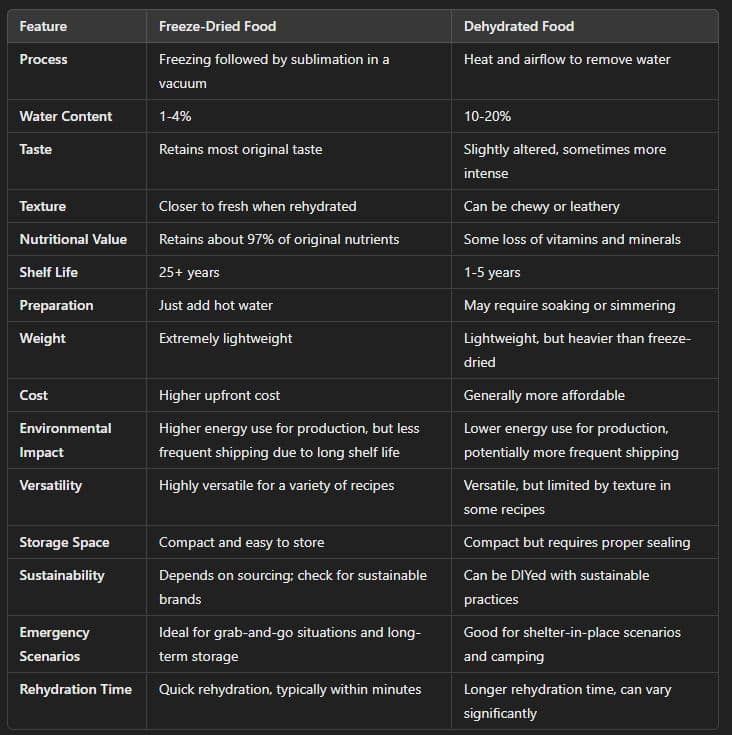Let’s settle a debate that has preppers buzzing like a generator after a
Both are solid choices for your emergency stash—lightweight, long-lasting, and ready to fuel you through any crisis.
But when it comes down to shelf life, nutrition, taste, and overall survival value, which one really takes the crown?
Is freeze-dried food the king of convenience, or does dehydrated food hold its ground as the budget-friendly contender? Are you better off with crunchy astronaut strawberries or a chewy pile of dried-out apple slices?
Let’s break it all down so you can make the smartest choice for your preparedness plan:
Understanding the Basics
First off, let’s get a handle on what these two terms mean.
You’ve probably seen freeze-dried and dehydrated foods on the shelves, but what’s the real difference?
Freeze-Dried Food
Freeze-dried food is made by freezing the food and then removing the water content through sublimation.
This involves placing the frozen food in a vacuum, which causes the ice to turn directly into vapor without passing through the liquid stage.
The result? Lightweight, shelf-stable food that retains much of its original taste, texture, and nutritional value.
Dehydrated Food
Dehydrated food, conversely, is made by removing the water content through heat and airflow.
This can be done using a dehydrator, an oven, or the sun.
While dehydrated food also becomes lightweight and shelf-stable, the process is a bit less gentle, and some flavor and nutrients can be lost in the process.
Freeze-Dried Food vs Dehydrated Taste and Texture
Let’s be honest—taste and texture matter.
When hunkered down in your bunker or camping out in the wilderness, you want your food to be as enjoyable as possible.
Freeze-Dried Food
Freeze-dried food generally wins in the taste and texture department.
Because the freeze-drying process preserves the food’s cellular structure, it tends to rehydrate closer to its original state.
Imagine biting into a freeze-dried strawberry that tastes almost as fresh as the day it was picked.
Pretty amazing, right?
Dehydrated Food
While still tasty, dehydrated food can be a bit of a mixed bag.
Dehydrated fruits like apples and bananas often turn out crispy and sweet.
However, some foods can become a bit leathery or chewy.
Think beef jerky or dried apricots.
They are still delicious, but not quite the same as fresh.
Nutritional Value
In an emergency, nutrition is key.
You want your food supply to keep you healthy and energized.
Freeze-Dried Food
Freeze-dried food retains about 97% of its original nutritional value.
The freeze-drying process locks in vitamins, minerals, and other nutrients, making it a solid choice for a well-rounded diet.
Dehydrated Food
Dehydrated food is still nutritious, but due to the heat involved in the process, it can lose some vitamins and minerals.
It’s not a massive drop, but it’s something to consider to maximize your nutritional intake.
Shelf Life Differences
Shelf life is crucial when it comes to emergency preparedness.
You want food that will last without constantly needing to rotate your stock.
Freeze-Dried Food
Freeze-dried food can last 25 years or more if stored properly. That’s right—25 years!
This makes it an excellent option for long-term storage.
Seal it in a Mylar bag with an oxygen absorber, and you’ll be ready for decades.
Dehydrated Food
Dehydrated food typically lasts 1 to 5 years, depending on the type and how it’s stored.
It’s still a good option, but you must be more diligent about rotating your supplies.
Preparation and Convenience
You don’t want to spend hours preparing a meal in a crisis.
Ease of preparation is a big plus.
Freeze-Dried Food
Freeze-dried food is incredibly easy to prepare.
Add hot water, wait a few minutes, and you’ve got a meal ready.
This is perfect for when you need to conserve energy and resources.
Dehydrated Food
Dehydrated food can require a bit more work.
Some items need to be soaked or simmered for a while before they’re ready to eat.
It’s not a huge deal, but it’s something to remember when planning your meals.
Weight and Portability
If you’re bugging out or heading off on a camping trip, the weight of your food matters.
Freeze-Dried Food
Freeze-dried food is ultra-light.
Removing the water content makes it incredibly easy to carry, so it’s a favorite among backpackers and hikers.
Dehydrated Food
Dehydrated food is also lightweight but usually not as light as freeze-dried.
It’s still a good option for portability, but you might notice a difference in your pack.
Freeze Dried Food vs Dehydrated Cost
Let’s talk dollars and cents.
Stocking up on emergency food isn’t cheap, so you want to get the best bang for your buck.
Freeze-Dried Food
Freeze-dried food tends to be more expensive upfront.
The technology and process involved drive up the cost.
However, considering its long shelf life, it can be a worthwhile investment.
Dehydrated Food
Dehydrated food is generally more affordable.
The process is simpler and less costly, so you can stock up without breaking the bank.
Just remember, you might have to replace it more often.
Environmental Impact
For those who also care about the planet, it’s worth considering the environmental impact of our food choices.
Freeze-Dried Food
The freeze-drying process requires significant energy to freeze and sublimate the food.
However, the long shelf life and lightweight nature mean less frequent production and shipping, which can offset some of the energy used.
Dehydrated Food
Dehydrating food, especially with solar dehydrators, can be more environmentally friendly.
The process uses less energy overall, but the shorter shelf life might mean more frequent production and shipping.
Versatility
You want your emergency food supply to be versatile and capable of adapting to various recipes and situations.
Freeze-Dried Food
Freeze-dried food rehydrates to near-original quality, making it versatile for all recipes.
From soups to stews to smoothies, it can do it all.
Dehydrated Food
Dehydrated food can also be versatile, but its texture can limit some uses.
It’s great for snacking, baking, and cooking, but it might not work as well in all recipes.
Storage Space
Space can be a premium, especially if you live in an apartment or have limited storage.
Freeze-Dried Food
Freeze-dried food is compact and lightweight, making it easy to store in large quantities.
You can stack those Mylar bags or cans neatly and forget about them for years.
Dehydrated Food
Dehydrated food also takes up little space, but you’ll need to be more mindful of where and how you store it.
Proper sealing and storage are crucial to maintaining its quality.
Sustainability in Sourcing
The sustainability of food sources can also be a consideration for eco-conscious preppers.
Freeze-Dried Food
Freeze-dried food can come from sustainable sources, but it’s essential to check the labels and research brands.
Look for those committed to ethical and sustainable practices.
Dehydrated Food
Similarly, dehydrated food can be sourced sustainably.
If you’re DIY-ing your dehydrated food, you have more control over where your food comes from, supporting local and sustainable agriculture.
Emergency Scenarios
Different emergency scenarios might call for different types of food.
Let’s see how each option stacks up.
Freeze-Dried Food
In a grab-and-go situation, freeze-dried food is king.
Its lightweight nature and easy preparation make it perfect for bug-out bags and quick evacuations.
The long shelf life also means you don’t have to worry about expiration dates during extended crises.
Dehydrated Food
Dehydrated food is great for situations where you have a bit more time and stability.
It’s excellent for shelter-in-place scenarios or when you’re camping and have the means to cook and prepare meals.
Its lower cost also makes it easier to build up a substantial supply.
Taste Test: Head-to-Head Comparison
Alright, let’s get to the fun part—a taste test!
Imagine you’ve got two options in front of you: freeze-dried and dehydrated versions of the same food.
How do they compare?
Strawberries
Freeze-dried strawberries are light and crispy and taste almost like fresh berries.
They’re perfect for snacking straight out of the bag or adding to cereal.
Dehydrated strawberries, while still tasty, can be a bit chewy.
They’re great in baked goods or rehydrated in water, but they don’t quite capture the fresh taste as well as freeze-dried.
Beef
Freeze-dried beef rehydrates to a texture that’s close to fresh-cooked meat.
It works well in stews, soups, and casseroles.
Dehydrated beef, like jerky, is tough and chewy.
It’s great for a protein-packed snack but not as versatile for cooking.
Peas
Freeze-dried peas are crunchy and can be eaten as a snack or rehydrated to use in recipes.
Dehydrated peas are smaller and harder, making them better suited for long-cooking dishes like soups and stews.
Making Your Decision
So, how do you choose between freeze-dried and dehydrated food for your emergency preparedness plan?
Here are a few tips to help you decide:
- Consider Your Needs: Think about your typical scenarios. Are you planning for quick evacuations or long-term sheltering in place?
- Balance Your Budget: Weigh the upfront costs against the long-term benefits. Freeze-dried might be pricier, but its long shelf life can be a great investment.
- Mix It Up: No rule says you can’t have both! Diversify your food storage with freeze-dried and dehydrated options to cover all your bases.
- Test It Out: Try samples of both types. See which ones you and your family prefer. This can help guide your purchasing decisions.
- Storage Conditions: Consider your storage conditions. If you have a cool, dry place with stable temperatures, either option will work well. If your storage is less than ideal, freeze-dried food might have an edge.
Freeze Dried Food vs Dehydrated – Final Thoughts
There’s no one-size-fits-all answer in the debate about freeze-dried vs. dehydrated food.
Both have strengths and weaknesses; the best choice depends on your needs and preferences.
Freeze-dried food offers superior taste, texture, and shelf life, making it ideal for long-term storage and quick, easy meals.
It’s the premium option, but you get what you pay for.
Dehydrated food is more budget-friendly and still offers good nutrition and versatility.
It’s perfect for those who want to build a substantial emergency supply without spending a fortune.
Ultimately, the smart prepper will likely include both in their food storage plan, leveraging the strengths of each to ensure they’re ready for whatever comes their way.
So, stock up, stay prepared, and stay safe out there!

Prepare, Adapt & Overcome,
P.s. - I just found out 2 out of 3 Americans don’t feel prepared for a 3 day disaster!!!
I guess this goes to show how modern society continues to embrace ‘living a fragile life.’ What’s crazy is… it’s so easy to fix.
To make sure YOU have the basics, watch our FREE training on “10 Simple Steps To Basic Preparedness” that shows you HOW.
Nothing crazy here… this isn’t doomsday prepping... just the basics every responsible adult should have before a disaster strikes.Why You Can Trust Skilled Survival...
Go here now to review a full breakdown of:
- Who We Are
- Our Credentials
- Our Mission
- & Product Recommendations...
Here are a few highlights of our teams credentials & certifications:
- Certified Member of a Mountain Search & Rescue Organization
- Plant Emergency & Safety Leader for a Major Food Manufacturer
- Member of the 10TH Mountain Division Hut Association
- Certifications: Avalanche 1, WFR, CPR
- Official Gear Tester for Numerous Outdoor Gear Companies
- Countless Multiday Backpacking trips into Remote Wilderness
- Bachelor's Degree In Mechanical Engineering
- Bachelor's Degree In Civil Engineering
- Bachelor's Degree In Biomedical Engineering
"It takes 20 years to build a reputation and five minutes to ruin it." - Warren Buffett
We're fully aware that trust is NOT something you GET but is EARNED.
And we'll continue to earn YOUR trust through our forthright and honest approach with each new Blog Post, Guide & Product we create...





